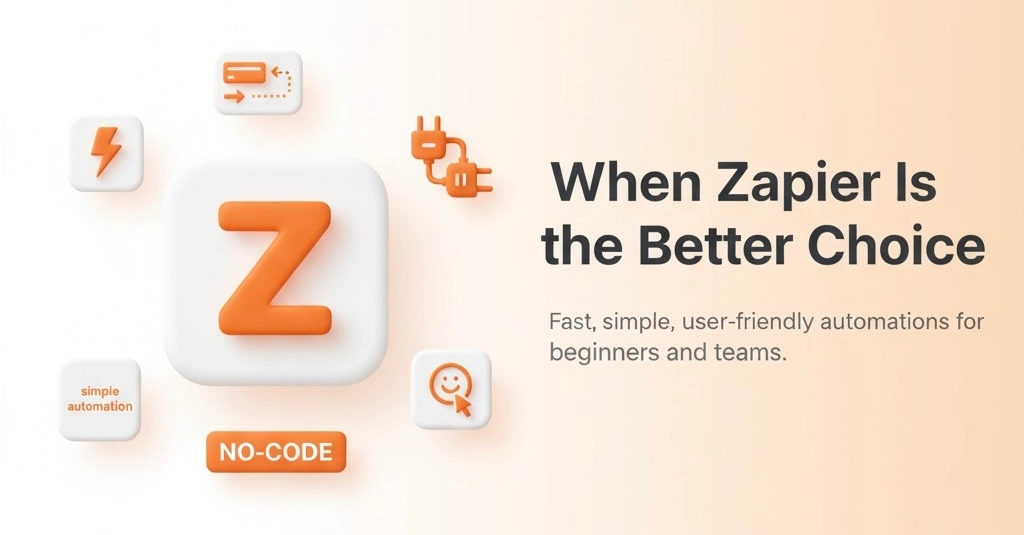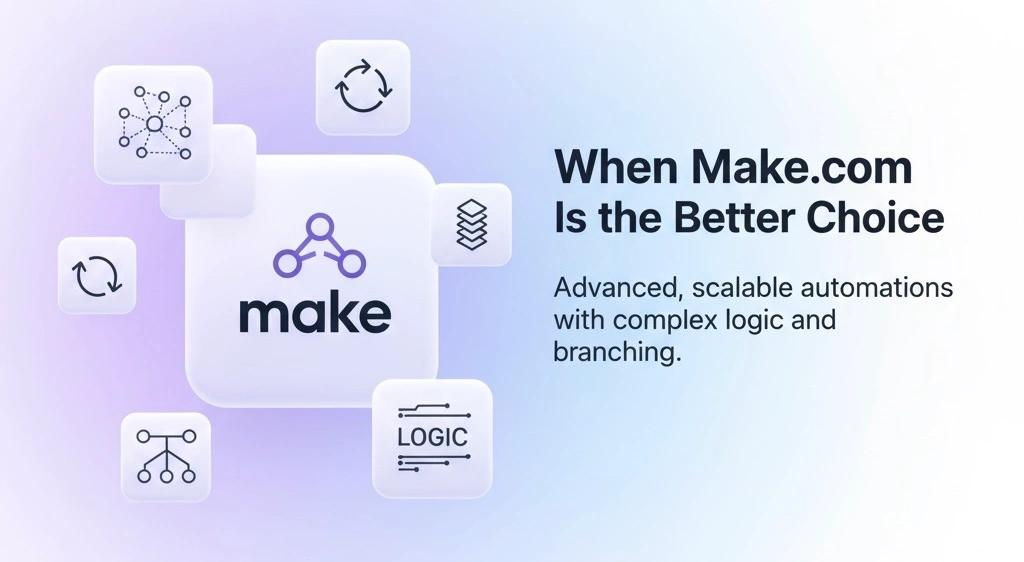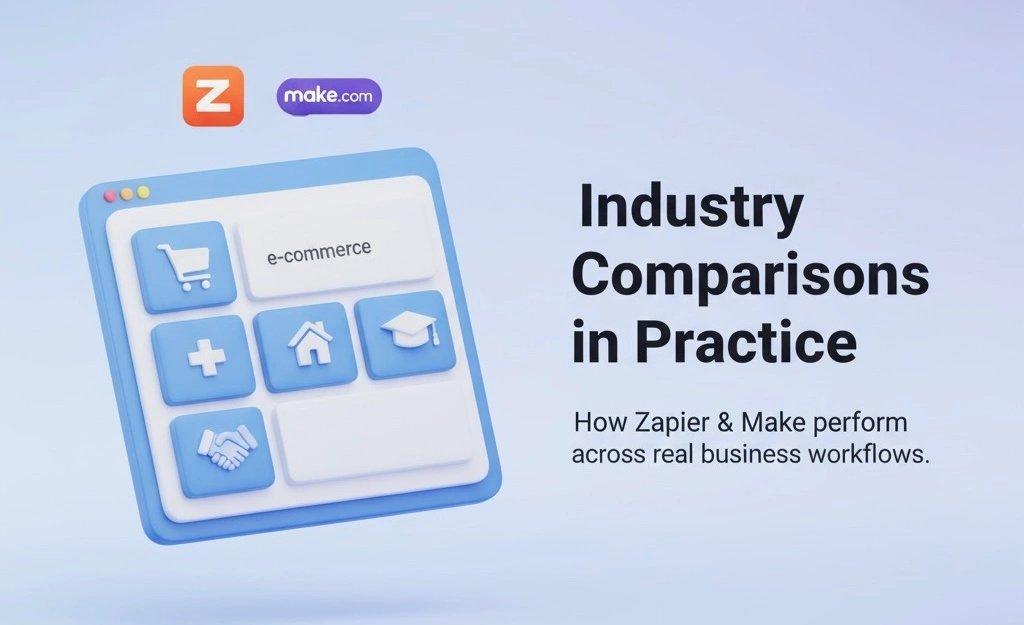Zapier vs Make.com: Which is Best for Your Business?
Every company exploring automation eventually reaches the same crossroad: should we choose Zapier or Make.com? The search terms “Zapier vs Make.com” and even “Zapier vs Integromat” remain some of the most common in the no-code ecosystem. Each of them plays a major role in automation, yet each was designed to solve different kinds of challenges. Zapier focuses on simplicity and speed, while Make.com, formerly known as Integromat, prioritizes complexity, flexibility, and cost-efficiency.
At Gonzo Digital, we see this debate play out daily. As both a certified Zapier agency and a Make.com consulting partner, we help startups, agencies, e-commerce brands, and enterprises pick the right platform. This page will give you a clear answer to real questions like “Is Make cheaper than Zapier?”, “Which has better integrations?”, and “When should I use Make instead of Zapier?”
A Head-to-Head Overview
The fundamental difference between Zapier and Make.com comes down to design philosophy. Zapier is built for accessibility. Its interface revolves around Zaps—linear automations that connect two or more apps in a straightforward trigger-and-action sequence. Anyone can build a Zap in minutes, which is why Zapier remains popular with small businesses and marketing teams.
Make.com takes a different approach. Instead of linear flows, it provides a visual scenario builder. With routers, the workflows handle branching, looping, and fine-tuned filters easily.In Make.com, you can set up a scenario that splits into different paths, loops back on itself, or filters data with Routers. It’s a little more hands-on to build, but it gives you options Zapier usually forces you to break into multiple Zaps. If your business needs live decision flows, heavy data processing, or to connect several systems at once, Make.com handles that in a way Zapier can’t.
When Zapier is the Better Choice
Zapier is often the first automation tool businesses try because of its ease of use. It is difficult to find a SaaS platform that doesn’t support Zapier because it has over 6,000 app integrations. This breadth makes it ideal for quick, lightweight workflows. A small business can automate invoices, reminders, or marketing campaigns in under an hour without needing a developer.
For agencies, Zapier is particularly powerful when standardizing processes across multiple clients. Tasks like generating reports, sending notifications, or updating spreadsheets can be built once and cloned across client accounts. Marketers also lean on Zapier to connect advertising platforms, CRMs, and email systems, often using it as part of their digital marketing services to run automated client onboarding workflows or schedule social media posts directly from a Google Sheet.
The limitation is scalability. Zapier relies on a task-based pricing model, which means every single action counts toward your quota. A five-step Zap processing 1,000 records burns through 5,000 tasks, at that scale the expense becomes noticeable. Zapier also struggles with error handling and bulk data. When you are prioritising accuracy, branching, or data processing, Zapier may feel too restrictive.
When Make.com is the Better Choice
Make.com shines when workflows grow beyond the linear structure Zapier supports. Make.com have visual canvas, through which users can design complex automations with unlimited branches, loops, and filters. Where Zapier offer limited conditional branching, Make.com’s Routers allow complex branching with greater control.
Pricing is another advantage. Make.com charges based on operations, not tasks. In practice, this means a complex workflow with many actions often costs significantly less on Make.com than on Zapier. Businesses processing thousands of invoices, reconciling accounts, or syncing customer data at scale usually find Make more cost-effective.
Use cases highlight these differences. A SaaS startup can use Make.com to sync data between HubSpot and Salesforce, apply regional filters, update Google Sheets in real time, and notify sales teams—all inside one scenario. A finance department can simplify reconciliation by linking data from several ERPs and banking systems, with results feeding directly into real-time dashboards. For e-commerce, Shopify processes can be automated at scale to keep stock levels, product information, and delivery updates aligned across all stores. On the other hand, Agencies often create custom reporting systems that pull data from ads, CRMs, and analytics, then refine it into clear reports ready for clients.
Make.com is more technical than Zapier, which means the learning curve is steeper, but users gain far greater flexibility, scale, and cost efficiency once they master it.
Pricing and Scalability Explained
Pricing is always the deciding factor in the Zapier vs Make.com debate. Zapier uses a task-based model. Every action performed is counted as a task. A workflow with multiple steps compounds the total quickly. For example, an invoicing Zap with five actions that runs 1,000 times in a month consumes 5,000 tasks. Even mid-tier plans can be exhausted quickly if workflows are data-intensive.
Make.com, in contrast, charges by operations. While an operation is similar to a task, the way Make groups steps together often means fewer operations overall for the same process. That invoicing example that cost 5,000 tasks on Zapier may only consume around 1,000 operations on Make.com. For high-volume businesses, this distinction translates directly into cost savings.
On free plans, Zapier offers 100 tasks per month with only single-step workflows. Make.com offers 1,000 operations on its free plan and allows multi-step scenarios, giving new users more room to experiment. The conclusion is simple: Zapier is affordable for light use, but Make.com is cheaper and more scalable for complex or data-heavy automations.
Feature Deep Dive: Logic, Error Handling, and APIs
One of the most significant comparisons is between Zapier Paths and Make Routers is Zapier’s Paths can manage basic branching conditional steps, but their depth is limited. Make’s Routers, on the other hand, let you build unlimited branches with layers of conditions, so workflows can adapt in real time to many different inputs. For example, routing leads based on geography, product interest, and account size simultaneously is far easier in Make.
Error handling also separates the platforms. Zapier retries tasks automatically or stops execution. Make.com, however, offers granular error controls. A failed step can be skipped, retried, rerouted, or logged separately without breaking the scenario. Businesses that rely on clean data pipelines find this especially useful.
Finally, API access demonstrates Make’s power. Zapier supports webhooks, which are functional but limited. Make provides full API modules with JSON parsing, advanced scheduling, and the ability to send and receive complex requests. This capability makes Make more than just an automation tool, giving it the role of a lightweight integration hub.
Industry Comparisons in Practice
Zapier works well for agencies that demand quick repeatable workflows like generating reports or posting content. While Make is better when agencies need to deliver custom analytics dashboards, pulling data from multiple client platforms.
For small businesses, Zapier’s ease of use is a real strength because teams can set up workflows on their own. Make may feel complex in the beginning, yet it proves its worth once a company scales and needs more advanced automation.
For e-commerce, Zapier handles order notifications and simple triggers. Make unlocks high-volume Shopify automation, synchronizing stock across multiple stores, managing logistics, and updating catalogs in real time.
Many teams don’t pick one tool over the other. Instead, they blend Zapier and Make.com for different layers of work. Zapier usually runs the front end—capturing leads, firing notifications, or starting campaigns. Make is better at the heavy branching: reconciliation, detailed reporting, and handling large-volume workflows.
Take a marketing agency as an example. Leads might flow from Zapier into HubSpot, then Make cleans, tags, and syncs that data into Salesforce. The mix reduces Zapier’s task load while using Make’s routers for stronger data processing. Here, at Gonzo Digital, we design these hybrid setups so clients get the best of both platforms without burning through budgets.
Zapier vs make
|
Feature |
Zapier |
Make.com |
|
How it Works |
It’s a simple list. You tell it: “When this happens, do that.” Each step follows the one before. It’s very easy to understand. |
You see your whole workflow at once. You drag apps and connect them with lines. It looks like a flowchart. |
|
Best For |
Quick and easy jobs. If you just need to connect two or three apps, Zapier is faster to set up. |
More complex jobs. If your task has many steps or needs to make decisions, Make handles it better. |
|
App Connections |
Has the most apps. With over 7,000 apps, it can connect almost anything you use right away. |
Has fewer apps (around 2,000). But it gives you a tool to connect to almost any service online if you have some technical skill. |
|
How You Build |
You fill out forms for each step. It’s a very guided and linear process. You can’t get lost. |
You drag modules around on a screen. You can build in any direction and create branching paths easily. |
|
Pricing |
You pay for every action that runs. This can get expensive if you have busy workflows with lots of steps. |
You pay for “operations.” This can be cheaper for big tasks, but even just checking for data uses up operations. |
|
Who Should Use It? |
People who want to save time on simple tasks. Good for beginners and anyone who values speed. |
People who want more control and power. Good for those who like to build systems and handle complex problems. |
|
Bottom Line |
Use Zapier for its huge app library and for getting simple automations running in minutes. |
Use Make when you need more control, have a complex task, or want a cheaper plan for high-volume work. |
Conclusion and Next Steps
The question Zapier vs Make.com doesn’t have a universal answer. The best option comes down to your business requirements.
Pick Zapier if speed, simplicity, and a wide set of integrations matter most, especially on a budget.
Go with Make.com when you need branching logic, bulk data handling, or scalable automation at lower costs.
Use both together if you want Zapier for quick front-end tasks and Make for more demanding back-end workflows.





